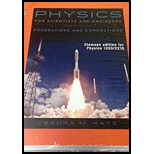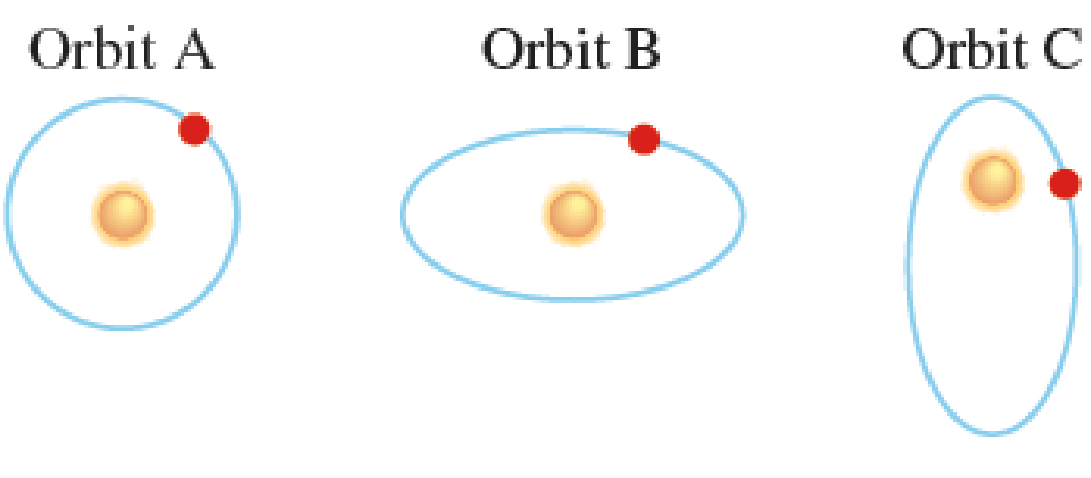
Physics for Scientists and Engineers: Foundations and Connections
15th Edition
ISBN: 9781305289963
Author: Debora M. Katz
Publisher: Cengage Custom Learning
expand_more
expand_more
format_list_bulleted
Textbook Question
Chapter 7.2, Problem 7.2CE
Three possible planetary orbits are shown in Figure 7.9. According to Kepler’s first law, which orbits are possible and which are not? Explain.

FIGURE 7.9
Expert Solution & Answer
Trending nowThis is a popular solution!

Students have asked these similar questions
Please solve and answer this problem correctly please. Thank you!!
Please solve and answer this problem correctly please. Thank you!!
a) Use the node-voltage method to find v1, v2, and
v3 in the circuit in Fig. P4.14.
b) How much power does the 40 V voltage source
deliver to the circuit?
Figure P4.14
302
202
w
w
+
+
+
40 V
V1
80 Ω 02
ΣΑΩ
28 A
V3 +
w
w
102
202
Chapter 7 Solutions
Physics for Scientists and Engineers: Foundations and Connections
Ch. 7.1 - What important experimental skills can we learn...Ch. 7.2 - Three possible planetary orbits are shown in...Ch. 7.2 - Prob. 7.3CECh. 7.2 - Prob. 7.4CECh. 7.2 - Todays employees are rewarded for thinking outside...Ch. 7 - We use the terms sunset and sunrise. In what way...Ch. 7 - Prob. 2PQCh. 7 - For many years, astronomer Percival Lowell...Ch. 7 - Prob. 4PQCh. 7 - Prob. 5PQ
Ch. 7 - Io and Europa are two of Jupiters many moons. The...Ch. 7 - Model the Moons orbit around the Earth as an...Ch. 7 - Prob. 8PQCh. 7 - Prob. 9PQCh. 7 - Prob. 10PQCh. 7 - Prob. 11PQCh. 7 - Prob. 12PQCh. 7 - A massive black hole is believed to exist at the...Ch. 7 - Since 1995, hundreds of extrasolar planets have...Ch. 7 - When Sedna was discovered in 2003, it was the most...Ch. 7 - Prob. 16PQCh. 7 - The mass of the Earth is approximately 5.98 1024...Ch. 7 - Prob. 18PQCh. 7 - Prob. 19PQCh. 7 - A black hole is an object with mass, but no...Ch. 7 - Prob. 21PQCh. 7 - Prob. 22PQCh. 7 - The Lunar Reconnaissance Orbiter (LRO), with mass...Ch. 7 - A Suppose a planet with mass m is orbiting star...Ch. 7 - Prob. 25PQCh. 7 - Three billiard balls, the two-ball, the four-ball,...Ch. 7 - Saturns ring system forms a relatively thin,...Ch. 7 - Prob. 28PQCh. 7 - Find the magnitude of the Suns gravitational force...Ch. 7 - Prob. 30PQCh. 7 - Prob. 31PQCh. 7 - Prob. 32PQCh. 7 - Prob. 33PQCh. 7 - Prob. 34PQCh. 7 - Prob. 35PQCh. 7 - In your own words, describe the difference between...Ch. 7 - The Sun has a mass of approximately 1.99 1030 kg....Ch. 7 - Prob. 38PQCh. 7 - Prob. 39PQCh. 7 - Prob. 40PQCh. 7 - Three billiard balls, the two-ball, the four-ball,...Ch. 7 - Prob. 42PQCh. 7 - Prob. 43PQCh. 7 - Prob. 44PQCh. 7 - Figure P7.45 shows a picture of American astronaut...Ch. 7 - Prob. 46PQCh. 7 - Prob. 47PQCh. 7 - Prob. 48PQCh. 7 - Prob. 49PQCh. 7 - Prob. 50PQCh. 7 - The International Space Station (ISS) experiences...Ch. 7 - Prob. 52PQCh. 7 - Two black holes (the remains of exploded stars),...Ch. 7 - Prob. 54PQCh. 7 - Prob. 55PQCh. 7 - Consider the Earth and the Moon as a two-particle...Ch. 7 - Prob. 57PQCh. 7 - Consider the Earth and the Moon as a two-particle...Ch. 7 - Prob. 59PQCh. 7 - You are a planetary scientist studying the...Ch. 7 - Prob. 61PQCh. 7 - Prob. 62PQCh. 7 - Planetary orbits are often approximated as uniform...Ch. 7 - Prob. 64PQCh. 7 - Prob. 65PQCh. 7 - Prob. 66PQCh. 7 - Prob. 67PQCh. 7 - Prob. 68PQCh. 7 - Prob. 69PQCh. 7 - Prob. 70PQ
Knowledge Booster
Learn more about
Need a deep-dive on the concept behind this application? Look no further. Learn more about this topic, physics and related others by exploring similar questions and additional content below.Similar questions
- Please solve and answer this problem correctly please. Thank you!!arrow_forwardYou're on an interplanetary mission, in an orbit around the Sun. Suppose you make a maneuver that brings your perihelion in closer to the Sun but leaves your aphelion unchanged. Then you must have Question 2 options: sped up at perihelion sped up at aphelion slowed down at perihelion slowed down at aphelionarrow_forwardThe force of the quadriceps (Fq) and force of the patellar tendon (Fp) is identical (i.e., 1000 N each). In the figure below angle in blue is Θ and the in green is half Θ (i.e., Θ/2). A) Calculate the patellar reaction force (i.e., R resultant vector is the sum of the horizontal component of the quadriceps and patellar tendon force) at the following joint angles: you need to provide a diagram showing the vector and its components for each part. a1) Θ = 160 degrees, a2) Θ = 90 degrees. NOTE: USE ONLY TRIGNOMETRIC FUNCTIONS (SIN/TAN/COS, NO LAW OF COSINES, NO COMPLICATED ALGEBRAIC EQUATIONS OR ANYTHING ELSE, ETC. Question A has 2 parts!arrow_forward
- The force of the quadriceps (Fq) and force of the patellar tendon (Fp) is identical (i.e., 1000 N each). In the figure below angle in blue is Θ and the in green is half Θ (i.e., Θ/2). A) Calculate the patellar reaction force (i.e., R resultant vector is the sum of the horizontal component of the quadriceps and patellar tendon force) at the following joint angles: you need to provide a diagram showing the vector and its components for each part. a1) Θ = 160 degrees, a2) Θ = 90 degrees. NOTE: USE DO NOT USE LAW OF COSINES, NO COMPLICATED ALGEBRAIC EQUATIONS OR ANYTHING ELSE, ETC. Question A has 2 parts!arrow_forwardNo chatgpt pls will upvotearrow_forwardThe force of the quadriceps (Fq) and force of the patellar tendon (Fp) is identical (i.e., 1000 N each). In the figure below angle in blue is Θ and the in green is half Θ (i.e., Θ/2). A) Calculate the patellar reaction force (i.e., R resultant vector is the sum of the horizontal component of the quadriceps and patellar tendon force) at the following joint angles: you need to provide a diagram showing the vector and its components for each part. a1) Θ = 160 degrees, a2) Θ = 90 degrees. NOTE: USE ONLY TRIGNOMETRIC FUNCTIONS (SIN/TAN/COS, NO LAW OF COSINES, NO COMPLICATED ALGEBRAIC EQUATIONS OR ANYTHING ELSE, ETC. Question A has 2 parts!arrow_forward
- ་ The position of a particle is described by r = (300e 0.5t) mm and 0 = (0.3t²) rad, where t is in seconds. Part A Determine the magnitude of the particle's velocity at the instant t = 1.5 s. Express your answer to three significant figures and include the appropriate units. v = Value Submit Request Answer Part B ? Units Determine the magnitude of the particle's acceleration at the instant t = 1.5 s. Express your answer to three significant figures and include the appropriate units. a = Value A ? Unitsarrow_forwardSolve and answer the question correctly please. Thank you!!arrow_forwardSolve and answer the question correctly please. Thank you!!arrow_forward
arrow_back_ios
SEE MORE QUESTIONS
arrow_forward_ios
Recommended textbooks for you
 Physics for Scientists and Engineers: Foundations...PhysicsISBN:9781133939146Author:Katz, Debora M.Publisher:Cengage Learning
Physics for Scientists and Engineers: Foundations...PhysicsISBN:9781133939146Author:Katz, Debora M.Publisher:Cengage Learning An Introduction to Physical SciencePhysicsISBN:9781305079137Author:James Shipman, Jerry D. Wilson, Charles A. Higgins, Omar TorresPublisher:Cengage Learning
An Introduction to Physical SciencePhysicsISBN:9781305079137Author:James Shipman, Jerry D. Wilson, Charles A. Higgins, Omar TorresPublisher:Cengage Learning AstronomyPhysicsISBN:9781938168284Author:Andrew Fraknoi; David Morrison; Sidney C. WolffPublisher:OpenStax
AstronomyPhysicsISBN:9781938168284Author:Andrew Fraknoi; David Morrison; Sidney C. WolffPublisher:OpenStax Foundations of Astronomy (MindTap Course List)PhysicsISBN:9781337399920Author:Michael A. Seeds, Dana BackmanPublisher:Cengage Learning
Foundations of Astronomy (MindTap Course List)PhysicsISBN:9781337399920Author:Michael A. Seeds, Dana BackmanPublisher:Cengage Learning Stars and Galaxies (MindTap Course List)PhysicsISBN:9781337399944Author:Michael A. SeedsPublisher:Cengage Learning
Stars and Galaxies (MindTap Course List)PhysicsISBN:9781337399944Author:Michael A. SeedsPublisher:Cengage Learning

Physics for Scientists and Engineers: Foundations...
Physics
ISBN:9781133939146
Author:Katz, Debora M.
Publisher:Cengage Learning

An Introduction to Physical Science
Physics
ISBN:9781305079137
Author:James Shipman, Jerry D. Wilson, Charles A. Higgins, Omar Torres
Publisher:Cengage Learning

Astronomy
Physics
ISBN:9781938168284
Author:Andrew Fraknoi; David Morrison; Sidney C. Wolff
Publisher:OpenStax

Foundations of Astronomy (MindTap Course List)
Physics
ISBN:9781337399920
Author:Michael A. Seeds, Dana Backman
Publisher:Cengage Learning

Stars and Galaxies (MindTap Course List)
Physics
ISBN:9781337399944
Author:Michael A. Seeds
Publisher:Cengage Learning

Kepler's Three Laws Explained; Author: PhysicsHigh;https://www.youtube.com/watch?v=kyR6EO_RMKE;License: Standard YouTube License, CC-BY